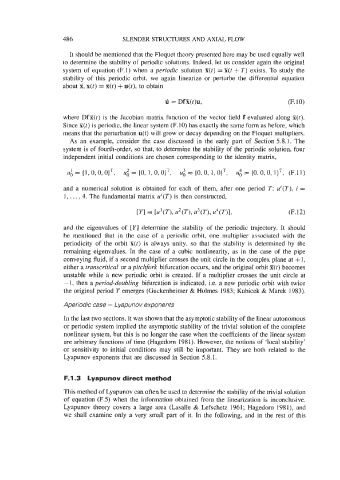Page 516 - Fluid-Structure Interactions Slender Structure and Axial Flow (Volume 1)
P. 516
486 SLENDER STRUCTURES AND AXIAL FLOW
It should be mentioned that the Floquet theory presented here may be used equally well
to determine the stability of periodic solutions. Indeed, let us consider again the original
system of equation (F.l) when a periodic solution %(t) = X(t + 7') exists. To study the
stability of this periodic orbit, we again linearize or perturbe the differential equation
about X, x(t) = X(t) + ~(t), to obtain
U = DfX(t)u, (F. IO)
where Df%(t) is the Jacobian matrix function of the vector field f evaluated along X(t).
Since X(t) is periodic, the linear system (F. 10) has exactly the same form as before, which
means that the perturbation u(t) will grow or decay depending on the Floquet multipliers.
As an example, consider the case discussed in the early part of Section 5.8.1. The
system is of fourth-order, so that, to determine the stability of the periodic solution, four
independent initial conditions are chosen corresponding to the identity matrix,
U: = [l,O,O,O}T, U; = [O, ui = (O,O, l,O}T, U: = [O,O,O, l}T, (F.ll)
and a numerical solution is obtained for each of them, after one period T: u'(T), i =
1, . . . ,4. The fundamental matrix u'(T) is then constructed,
and the eigenvalues of [Y] determine the stability of the periodic trajectory. It should
be mentioned that in the case of a periodic orbit, one multiplier associated with the
periodicity of the orbit X(t) is always unity, so that the stability is determined by the
remaining eigenvalues. In the case of a cubic nonlinearity, as in the case of the pipe
conveying fluid, if a second multiplier crosses the unit circle in the complex plane at +l,
either a transcritical or a pitchfork bifurcation occurs, and the original orbit X(t) becomes
unstable while a new periodic orbit is created. If a multiplier crosses the unit circle at
- 1, then a period-doubling bifurcation is indicated, i.e. a new periodic orbit with twice
the original period T emerges (Guckenheimer & Holmes 1983; Kubicek & Marek 1983).
Aperiodic case - L yapunov exponents
In the iast two sections, it was shown that the asymptotic stability of the linear autonomous
or periodic system implied the asymptotic stability of the trivial solution of the complete
nonlinear system, but this is no longer the case when the coefficients of the linear system
are arbitrary functions of time (Hagedorn 1981). However, the notions of 'local stability'
or sensitivity to initial conditions may still be important. They are both related to the
Lyapunov exponents that are discussed in Section 5.8.1.
F.1.3 Lyapunov direct method
This method of Lyapunov can often be used to determine the stability of the trivial solution
of equation (F.5) when the information obtained from the linearization is inconclusive.
Lyapunov theory covers a large area (Lasalle & Lefschetz 1961; Hagedorn 1981), and
we shall examine only a very small part of it. In the following, and in the rest of this

